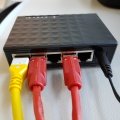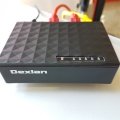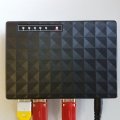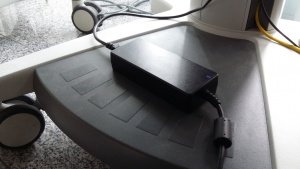Electronic Fundamentals
The interaction between the electrical components of the SRM – High Performance Ergometer allows precise power control for performance diagnostic examination and scientific data acquisition.
Contents
The PowerMeter
The PowerMeter is the central part of the ergometer. It is responsible for measuring the power output. The PM transmits a particular frequency (500 - 12.000 Hz) proportional to the actual torque and also a frequency proportional to the actual angular velocity via a transmitter to a receiver located on the frame. The signal is digital to eliminate transmission errors. Power supply of the PM is by a Lithium battery lasting 1800 hours.
Important: If there is no torque on the chain, the PM does not measure any frequency, which means the angular velocity is zero. Setting this zero offset correctly is important to receive the right measurement of power output.
In the factory we calibrate all SRM PowerMeters in order to determine the frequency change of PowerMeter when changing the torque on the cranks. This frequency is called slope. This slope, measured in Hz/Nm, has to be entered initially into the PowerControl. The slope only has to be reentered if a different PowerMeter is employed, which normally has also a different slope.
Connecting the Ergometer (Ports)
- - Power Supply
- - Serial Port
- The serial port is only for the external control by CPX/CPET, EKG or other medical devices by the so called “ergoline” protocol. The idea is to specify the protocols in the CPX/CPET or EKG software to be independend of the SRM Ergometer software.
- Please connect the SRM ergometer via the serial port and the USB-to-Serial Adapter to the controlling computer.
- Please note: If you like to control the protocol by an external device don’t start the performance diagnostics in the SRM ergometer software. The SRM ergometer software are dominant.
- - Torque Analysis
- - Ethernet Ergometer
Ethernet hub
An Ethernet hub is a network hardware device for connecting multiple Ethernet devices together and making them act as a single network segment. If, for example, a notebook has only 1 Ethernet port this offers a solution. Because if you want to you use both the Ergometer and the Torque Analysis you will need 2 Ethernet ports. It is most likely is does not matter which Ethernut hub you will use but we recommend to take the Dexlan Ethernet hub because is has been tested with the SRM Ergometer.
The PowerControl Ergometer
The PowerControl of the SRM Ergometer is responsible for storing the measured data, controlling the eddy current brake and transmitting signals to the computer via a serial cable. The Power Control Ergometer is the new version of the Power Control.
Power output is calculated in the PC in the following manner:
Average torque of a full crank rotation x average angular velocity of a full crank rotation = average power of a full crank rotation.
Average values are calculated on the time basis of one second. Thus the power value is always displayed with a one second delay. An example: The athlete pedals with 90 rotations per minute or 1.5 rotations per sec. The calculated performance is in this case the average value during 1.5 crank rotations. To conduct this calculation the next full crank rotation has to be completed in order to know which value of the previous time basis has to be employed. Basis of performance calculations are therefore always full rotations which are calculated on the time basis (1 sec).
A common time basis is necessary in order to synchronize all measured values of heart rate, cadence, power, and speed. Without calculation based on a common time basis and the relationship to the position of the crank, the measured value for power would fluctuate wildly.
Power supply of the PowerControl unit is ensured via an integrated accumulator, which is constantly charged when the power supply is switched on. To employ the PowerControl on the Ergometer one has to ensure that the zero offset and slope are correctly entered. All other values such as sampling frequency, wheel size, etc. are in this case not applicable.
Since the PowerControl saves all data, the user has a second set of data which he can use e.g. if the computer has crashed or has lost its data.
The main menu shows real-time data as the athlete trains. Press MODE to change between the different information modes on your display.
- Real-time Training Data Menu:
- Top Line: Total training time, training time cadence > 0, distance [miles or km], ascending altitude [feet or m] or all four alternating (Setting can be changed in the SRM Windows Software).
- Middle Line: Power [Watt] (> 1000W, 1.0 = 1000W), heart rate [bpm].
- Bottom Line: Training zone, speed [km/h or miles/h], cadence [rpm].
- If no signal from a sensor is picked up, the display shows “-“ for this data instead of a number (for example “-“ speed if the speed sensor is not working).
- Average Training Data Menu:
- Top Line: Total training time, training time cadence > 0, distance, altitude or all four alternating.
- Middle Line: Power, heart rate.
- Bottom Line: Speed, cadence.
- Maximum Training Data Menu:
- Top Line: Mechanical energy uptake in kilojoules [kJ]
- (Estimating an efficiency of 25% riding the bike, this is approximately the same as the total energy burned by the athlete in kcal).
- Middle Line: Power, heart rate.
- Bottom Line: Speed, cadence.
- Time/Date Menu:
- Top Line: Time of day.
- Middle Line: Day, month.
- Bottom Line: Year, temperature in Celsius or Fahrenheit.
Control test with PowerControl keys
You have the possibility to start and stop the test (or the training session) with the keys of the PowerControl.
The useful settings: See Control test with PowerControl keys
Sensor Pairing
You need to pair the PowerControl Ergometer with the power, speed and heartrate sensors.If you don’t do this, no data will be received by the PowerControl Ergometer for any of the sensors that you want to use on your bike.
Pairing the sensors with the PowerControl Ergometer will only be possible if they are switched on.
- Switch on the PowerMeter by pedaling the crank forward a few times (it will switch on when the sensor in the PowerMeter passes the magnet attached to the bottom bracket).
- Switch on the speed sensor by spinning the wheel.
- Switch on heartrate sensor by putting the belt on your chest. Please moisten the electrodes to improve contact.
- Switch on the PowerControl by pressing the MODE button.
Hold PRO for about 3 seconds to enter Sensor Pairing mode. Press MODE once quickly to select the device you want to pair and press SET once quickly to tell the PC Ergometer to start searching. The Antenna symbol blinking on the right of the display shows that the searching process has started. The search bar in the middle of the display shows the progress of the search.
If no signal is picked up, please check:
- If the sensor is switched on.
- The position of the magnet.
- Depending on the total miles/km your PowerMeter battery might be empty.
- If it is still not working, please get in touch with the SRM Service Center.
When a sensor is found, the PC Ergometer will show “Found” in the top line, alternating with the sensor’s serial number. If the pairing fails, please repeat pairing from the beginning. To pair another sensor, press MODE once quickly to get back to the device selection Menu. Continue with pairing the heart rate sensor and speed sensor. Hold MODE for about 3 seconds to leave the device pairing menu and go back to the main menu. It is also possible to program the sensor identification numbers in the SRM Windows Software. Then manual pairing is not necessary.
Plugs
In the following list you find the technical meanings of the plugs at the rear of the PowerControl. Please consider that the number of plugs can distinguish between the different model types. And please be careful in handling the plugs, because the pins inside the plugs are very sensitiv.
- Plug of the PowerControll Ergometer (s. picture)
- male, 4 pins
- Eddy current brake instructions from PowerControl to the power supply
- Charging
- Speed
The Power Supply
The power supply has been especially designed to suit the SRM Performance Ergometer. The power supply changes the magnetic field in the eddy current brake very rapidly to ensure a constant rotational speed in isokinetic mode. In the isokinetic mode it is necessary to reduce the braking power to near zero when the cranks are in vertical position. In horizontal position the braking power has to be up to 4000 watts. This is necessary to maintain the predetermined rotational pedaling speed. This means that at a cadence of 120 rotations per minute the magnetic field in the brake has to be established and abolished four times per second.
The power supply operates with 220 Volts, and incorporates fuses of 1.3 A. The power point which is used for the power supply has to be well earthed (grounded) in order to avoid that the athletes become electrostatically charged. WARNING: Operation of the ergometer through an unsatisfactorily earthed power point can damage the health of the athlete and the physiologist and can also lead to wrong ECG readings.
The operating mode of the power supply is indicated by a green LED display. The yellow LED display indicates the operation of the brake. The yellow LED has to flash during isokinetic mode.
Place the power supply in dry, well aired condition. Avoid switching the power supply on and off in quick succession. Never clean the power supply with water or other fluids, the electronics will be damaged.
The current transmitted by the power supply is +/- 24 Volt. The power supply charges the PowerControl unit. If the PowerControl is not charged over a period of about 3 months, it may lose the programmed operating parameters. In this case the user has to charge up the PC via the dedicated charger and enter all operating parameters again with the software SRMWIN.
The power supply does usually not need any maintenance. Wipe with a dry cloth and be sure that no moisture gets into it.
Light Barrier
The light barrier measures the speed of the fly masses. She is a necessity for the power measurement. If speed is not measured correctly, the power measurement is not correct either. The displayed speed values in the SRMWin-Software - e.g. during a performance test – do not correspond to real speed values.
Adjustments
It is possible to do some adjustments to the SRM Ergometer if it is necessary.
Relocating Plug
The cable of the PowerControl could be too short with the new SRM Ergometers. This occurs by pulling up the steering wheel of the Ergometer. In order to solve this the plug of the PowerControl will be relocated.
Grounding
Not every SRM Ergometer has been grounded thoroughly for international standards. This could be fixed easily by adding some more grounding like in the images below.


















